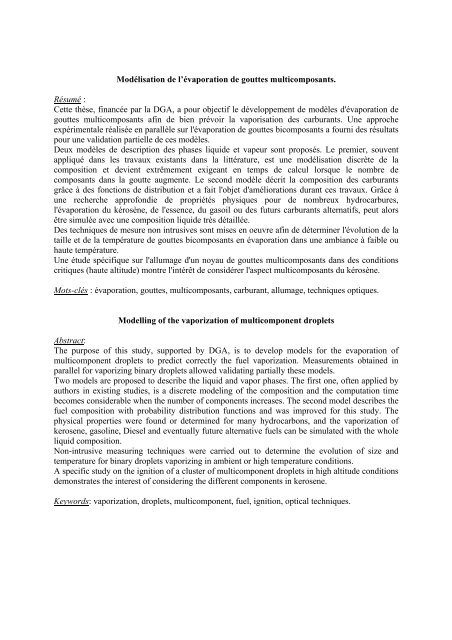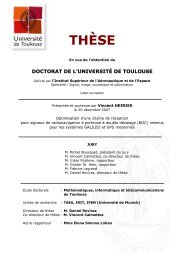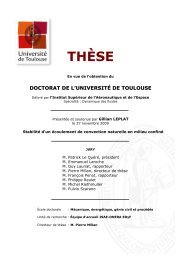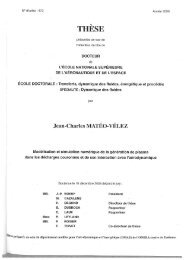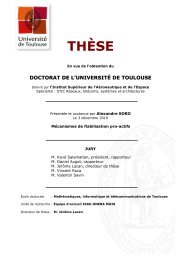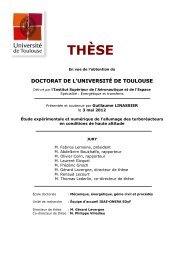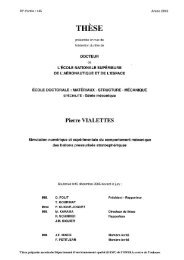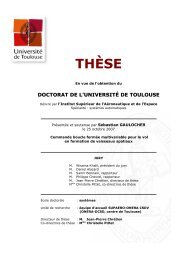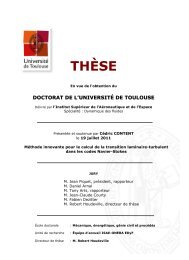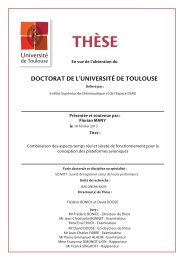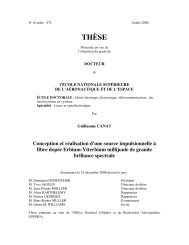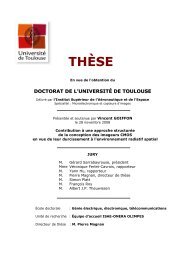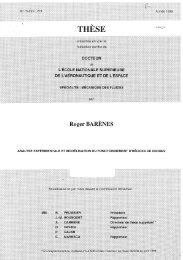Modélisation de l'évaporation de gouttes multi-composants
Modélisation de l'évaporation de gouttes multi-composants
Modélisation de l'évaporation de gouttes multi-composants
You also want an ePaper? Increase the reach of your titles
YUMPU automatically turns print PDFs into web optimized ePapers that Google loves.
<strong>Modélisation</strong> <strong>de</strong> l’évaporation <strong>de</strong> <strong>gouttes</strong> <strong>multi</strong><strong>composants</strong>.Résumé :Cette thèse, financée par la DGA, a pour objectif le développement <strong>de</strong> modèles d'évaporation <strong>de</strong><strong>gouttes</strong> <strong>multi</strong><strong>composants</strong> afin <strong>de</strong> bien prévoir la vaporisation <strong>de</strong>s carburants. Une approcheexpérimentale réalisée en parallèle sur <strong>l'évaporation</strong> <strong>de</strong> <strong>gouttes</strong> bi<strong>composants</strong> a fourni <strong>de</strong>s résultatspour une validation partielle <strong>de</strong> ces modèles.Deux modèles <strong>de</strong> <strong>de</strong>scription <strong>de</strong>s phases liqui<strong>de</strong> et vapeur sont proposés. Le premier, souventappliqué dans les travaux existants dans la littérature, est une modélisation discrète <strong>de</strong> lacomposition et <strong>de</strong>vient extrêmement exigeant en temps <strong>de</strong> calcul lorsque le nombre <strong>de</strong><strong>composants</strong> dans la goutte augmente. Le second modèle décrit la composition <strong>de</strong>s carburantsgrâce à <strong>de</strong>s fonctions <strong>de</strong> distribution et a fait l'objet d'améliorations durant ces travaux. Grâce àune recherche approfondie <strong>de</strong> propriétés physiques pour <strong>de</strong> nombreux hydrocarbures,<strong>l'évaporation</strong> du kérosène, <strong>de</strong> l'essence, du gasoil ou <strong>de</strong>s futurs carburants alternatifs, peut alorsêtre simulée avec une composition liqui<strong>de</strong> très détaillée.Des techniques <strong>de</strong> mesure non intrusives sont mises en oeuvre afin <strong>de</strong> déterminer l'évolution <strong>de</strong> lataille et <strong>de</strong> la température <strong>de</strong> <strong>gouttes</strong> bi<strong>composants</strong> en évaporation dans une ambiance à faible ouhaute température.Une étu<strong>de</strong> spécifique sur l'allumage d'un noyau <strong>de</strong> <strong>gouttes</strong> <strong>multi</strong><strong>composants</strong> dans <strong>de</strong>s conditionscritiques (haute altitu<strong>de</strong>) montre l'intérêt <strong>de</strong> considérer l'aspect <strong>multi</strong><strong>composants</strong> du kérosène.Mots-clés : évaporation, <strong>gouttes</strong>, <strong>multi</strong><strong>composants</strong>, carburant, allumage, techniques optiques.Mo<strong>de</strong>lling of the vaporization of <strong>multi</strong>component dropletsAbstract:The purpose of this study, supported by DGA, is to <strong>de</strong>velop mo<strong>de</strong>ls for the evaporation of<strong>multi</strong>component droplets to predict correctly the fuel vaporization. Measurements obtained inparallel for vaporizing binary droplets allowed validating partially these mo<strong>de</strong>ls.Two mo<strong>de</strong>ls are proposed to <strong>de</strong>scribe the liquid and vapor phases. The first one, often applied byauthors in existing studies, is a discrete mo<strong>de</strong>ling of the composition and the computation timebecomes consi<strong>de</strong>rable when the number of components increases. The second mo<strong>de</strong>l <strong>de</strong>scribes thefuel composition with probability distribution functions and was improved for this study. Thephysical properties were found or <strong>de</strong>termined for many hydrocarbons, and the vaporization ofkerosene, gasoline, Diesel and eventually future alternative fuels can be simulated with the wholeliquid composition.Non-intrusive measuring techniques were carried out to <strong>de</strong>termine the evolution of size andtemperature for binary droplets vaporizing in ambient or high temperature conditions.A specific study on the ignition of a cluster of <strong>multi</strong>component droplets in high altitu<strong>de</strong> conditions<strong>de</strong>monstrates the interest of consi<strong>de</strong>ring the different components in kerosene.Keywords: vaporization, droplets, <strong>multi</strong>component, fuel, ignition, optical techniques.


